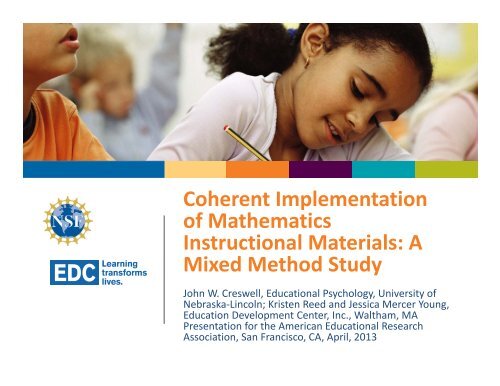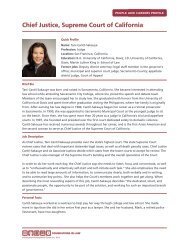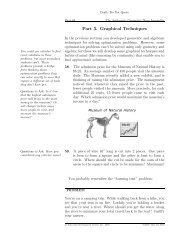A Mixed Method Study - Education Development Center, Inc.
A Mixed Method Study - Education Development Center, Inc.
A Mixed Method Study - Education Development Center, Inc.
Create successful ePaper yourself
Turn your PDF publications into a flip-book with our unique Google optimized e-Paper software.
Coherent Implementationof MathematicsInstructional Materials: A<strong>Mixed</strong> <strong>Method</strong> <strong>Study</strong>John W. Creswell, <strong>Education</strong>al Psychology, University ofNebraska‐Lincoln; Kristen Reed and Jessica Mercer Young,<strong>Education</strong> <strong>Development</strong> <strong>Center</strong>, <strong>Inc</strong>., Waltham, MAPresentation for the American <strong>Education</strong>al ResearchAssociation, San Francisco, CA, April, 2013
Objectives of the Session• Describe a multilevel mixed methods study.• Highlight seven mixed methods features of thestudy.• Discuss the challenges in conducting thestudy.edc.org
The Mathematics InstructionalMaterials <strong>Study</strong>• Fourth year of four‐year NSF‐funded project.• Investigates the implementation of elementarymathematics materials: Everyday Mathematics andInvestigations in Number, Data, and Space.• Central hypothesis: School districts that have greatercoherence in their support for curriculumimplementation will see stronger student outcomes.• Data collected from 12 districts, 153 schools, 2172teachers in 5 states; outcome data from fourth‐grademathematics state assessments.edc.org
edc.orgRelation Among the Constructs
Data Collection• Teacher surveys (4, N=2172)• Principal surveys (2, N=153)• Math support person survey (N=78)• Site visits, interviews with 26 district staff• Review of district implementation documents• Interviews with teachers and principals in asubsample of 40 schoolsedc.orgMathematics Instructional Materials <strong>Study</strong>
Why Choose <strong>Mixed</strong> <strong>Method</strong>s?• Explanatory analysis to explore themes andrelationships.• Convergent validity: Validating the constructsof school use and school support.• Multilevel design required the collection ofqualitative and quantitative data and astrategy to analyze and merge the data.edc.org
<strong>Mixed</strong> <strong>Method</strong>s Aspects of the <strong>Study</strong>• Visual display of multilevel design• Points of interface• Parallel questions• Use of joint displays• Resolving discrepancies• <strong>Mixed</strong> methods team• Publishing findingsedc.org
Visual and Multilevel Display & Points of Interfaceedc.org
edc.orgParallel Questions: Pacing Guide
edc.orgJoint Display
edc.orgResolving Discrepancies
The <strong>Mixed</strong> <strong>Method</strong>s Academic Team• Institutional support• Creating common understandings• Bridge person(s)• Learning opportunities• <strong>Method</strong>ological consultants• Working jointly on qualitative and quantitativeaspects• Team leadershipedc.org
Planning for Paper Publications as a TeamTitle/Focus of Paper Target Journal Data Sources Who’s Responsible? DeadlineCoherentImplementation ofMathematicsInstructional Materials:A multilevel mixedmethods studyCoherent Support forElementaryMathematics Materials:Impacts on teacher useand student outcomesImpact of DistrictPolicy on ElementaryStudents MathematicsAchievementA methodology journalin mixed methodsA mathematicseducation researchjournalAn education policyjournalDiscussions ofmethodologicaloccurrencesJoint displays andanalysisJoint displaysQuantitative analysisSubstudy on districtcoherenceQuantitative analysis ofstudent outcomesDS, JC, KR, JYThis includes a PI, ourmixed methods advisor,a qual researcher, and aquant researcherDS, JM, KR, JYThe two lead authorsare the PIs; team alsoincludes a qualresearcher and a quantresearcherKR, JY, DSThe lead author is a qualresearcher supported bya quant researcher and aPI… … … … …April 2013July 2013July 2013edc.org
Lesson Learned and Challenges• Parallel data are key.• Stay close to raw data when merging.• Discrepancies point to interesting questionsand guide interpretations.• Pay attention to variations in the type of dataand varying sample size at different levels inmultilevel design.edc.org
Questions• Kristen Reed, kreed@edc.org• Jessica Young, jyoung@edc.org• John Creswell, jcreswell1@unl.eduPaper: http://go.edc.org/2013‐AERA‐CI‐PaperSlides: http://go.edc.org/2013‐AERA‐CI‐Slidesedc.org
Coherent Implementationof MathematicsInstructional Materials: A<strong>Mixed</strong> <strong>Method</strong> <strong>Study</strong>John W. Creswell, <strong>Education</strong>al Psychology, University ofNebraska‐Lincoln; Kristen Reed and Jessica Mercer Young,<strong>Education</strong> <strong>Development</strong> <strong>Center</strong>, <strong>Inc</strong>., Waltham, MAPresentation for the American <strong>Education</strong>al ResearchAssociation, San Francisco, CA, April, 2013
















